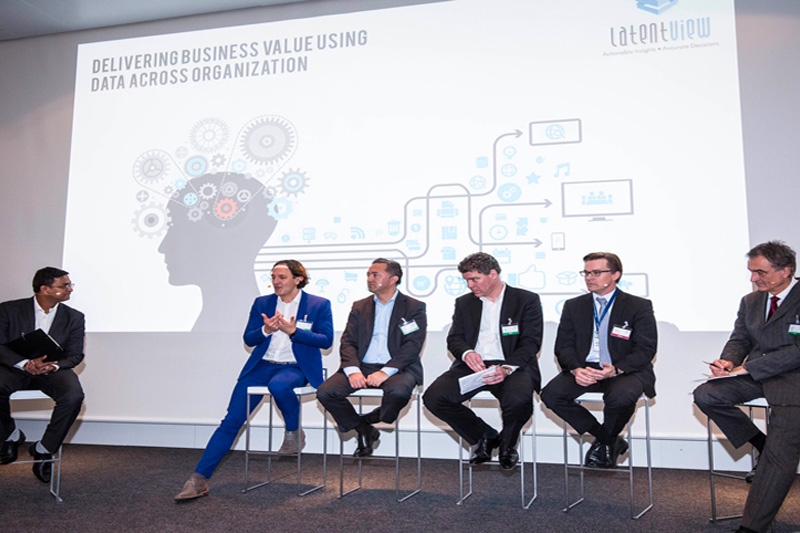
Data Science & AI as key enablers in business transformation
Excerpts from LatentView’s Eighth Analytics Roundtable at Munich, Germany
Keynote
Jens Monsees, VP Strategy Digitalization, BMW Group
Jens Monsees, VP Strategy Digitalization, BMW Group, shared insights into BMW’s digital transformation journey leveraging the power of advanced analytics – that will help the company reach the goal of 100 million customers by 2025.
The data is permanently available and growing strongly. By 2020, IDC predicts the volume of digital data will have reached 40 Zettabytes. Bringing the data sources together and making the right hypothesis will give organizations a competitive edge, said Jens.
Jens painted a picture into the future where growth will be delivered not just by the traditional business models but by newer business models like cars as a service, leading into mobility as a service, which ultimately will combine with digital players to provide a complete, connected life. The mobility of the future will be autonomous and data-driven with AI as a key enabler.
Presenting an industry outlook, Jens spoke about how smart cities could be created only through the collaboration of corporations, the public sector and startups. He stressed the importance of leveraging the power of analytics to create a knowledge sharing platform in the automobile as well as other industries, to help realize this goal of connected mobility.
Panel Discussion
Data Strategy: Delivering business value using data across organization

Speakers: Solmaz Altin (EVP, Chief Digital Officer, Allianz Group); Tim Berger (Vice President – Consumer Products, L’oreal); Stefan Grunwald (Head, Corporate Quality Targets, Process and Data Management, BMW); Martin Wild (Chief Digital Officer, MediaMarktSaturn Retail Group); Gerhard Baum (Chief Digital Officer, Schaeffler).
Data strategies to maximize value and the challenges faced by the data and analytics leaders across organizations were the focus of this panel discussion.
- Key drivers for strategy and organization of data are driven by the type of industry, richness of data and regulations around data governance.
- The decision to gather data from newer sources and maximizing value from the collected data differs depending on the industry, but it is driven primarily by the context and purpose each time.
- Sharing and collaborating data across the value chain is essential, but should be done in an optimal manner.
- External data and social intelligence is a crucial to augment the internal intelligence and also serves an important purpose when it comes to leveraging business decisions.
- Organizations should start quantifying their sustainability and green initiatives using the power of advanced analytics and data.
- E-commerce and marketplace models are under pressure, but what is essential is to engage customers in an omni-channel context rather than focus only on digital touch points.
- Shared economies and Artificial Intelligence will bring more collaborations and it will be an open playing field with data-driven organizations emerging as leaders.
Case Study on Social Intelligence:Making Data Sing!

Reed Cundiff, General Manager of Microsoft’s Customer & Market Research (CMR) team, shared his experience in transforming the CMR practice by enabling data driven decision making.
He elaborated on the necessity to manage multiple data streams, technical infrastructure, redefining the role of Research Managers and leveraging external partners like LatentView Analytics to provide incisive insights to guide and inform internal stakeholders on corporate initiatives. This was also applicable to business issues across Microsoft, including marketing, business planning, and engineering. Reed’s presentation touched upon some of the key initiatives at CMR across Data Surfacing, Data Integration, Real Time Analysis and Data Visualization – all of which are required to deliver value to the senior leadership.
Subramanian Ramachandran, Director – Client Relationships at LatentView Analytics, concluded the presentation by sharing a couple of case studies where LatentView, in partnership with Microsoft, was able to leverage Social Media Data, CMR’s Social Intelligence Platform and robust frameworks to drive business insights which in turn enabled positive business decisions.
Panel discussion
Analytics Strategy: Leveraging analytics for strategic business transformation
Speakers: Simon Bailey (Head of Business Insights, Aberdeen Standard Investments); Julius Ganns (Head of Digital, Vorwerk); Kai Demtröder (Head of Data Lake, Big Data & Advanced Analytics, BMW Group); Moritz Klämt (Global Digital Director, Henkel).
Organisations are grappling with the challenge of how to define the business value upfront before embarking on analytics initiatives. There are many approaches to define business use cases for analytics.
Some organizations prefer laying out a detailed financial model that captures expected returns from the initiative. However, for most organizations, it’s not easy to quantify the benefits and tie them to hard numbers. A lot of these benefits are not concrete, such as improved access to data, faster time to decisions, etc. Moreover, it’s not easy to assess all the benefits upfront, especially for infrastructure build out where the benefits come from downstream usage of the infrastructure. Instead, it’s important to look at parameters such as the number of downstream use cases supported.
While talking about what kind of analytics model to adopt, the common consensus amongst the speakers was that the hub-and-spoke model for analytics works best, and it is necessary to strike a balance between centralization and decentralization. While centralization leads to consistency of results, it comes at the cost of agility. Adopting a decentralized approach leads to faster time to insights, but issues arise in scaling up analytics.
The panel closed with a detailed discussion on General Data Protection Regulation (GDPR) and how companies are still grappling with the challenge of creating a scalable solution that meets the compliance requirements. The major challenge is that consumer data is spread across the entire data ecosystem, so it’s difficult to surface it as it’s being used for various purposes. This becomes all the more challenging in the context of an IoT driven world, where data is gathered by multiple devices, and there’s no clear ownership of the data.